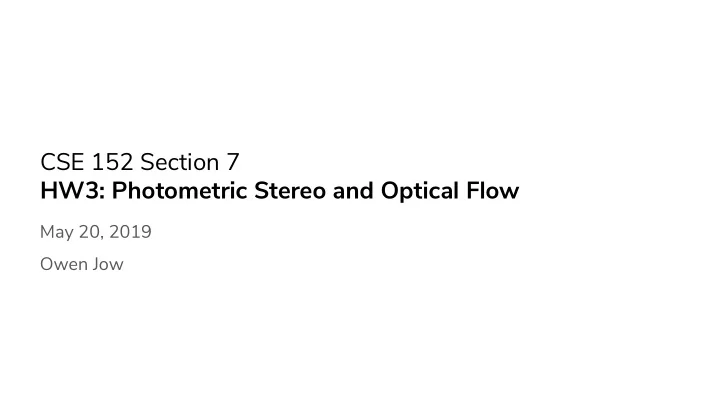

CSE 152 Section 7 HW3: Photometric Stereo and Optical Flow May 20, 2019 Owen Jow
[1a] Lambertian Photometric Stereo Input: Output: images and associated lighting information normals, albedo, depth light source direction: [0, 0, 1] T light source direction: [0.2, 0, 1] T Photometric Stereo light source direction: [-0.2, 0, 1] T light source direction: [0, 0.2, 1] T
[1a] Assumptions Orthographic camera model: ● (x, y, z) projects to (x, y) → our goal will be to recover the height/depth map z = f(x, y) Distant lighting: ● treat every pixel in one image as sharing the same lighting direction/intensity Static scene/viewpoint: ● (x, y) in one image corresponds to (x, y) in all of the other images image source: Forsyth and Ponce
[1a] Assumptions, cont. (Lambertian) Lambertian surface: ● assume that the surface being imaged is Lambertian, i.e. at any point on the surface, there is equal reflectance in all directions e(x, y) intensity at pixel (x, y) (known) a(x, y) albedo at the point on the surface corresponding to (x, y) (unknown) image source: Wayne Brown n (x, y) unit normal at the point on the surface corresponding to (x, y) (unknown) s unit direction to the light, scaled by the intensity of the light (known)
[1a] Solving for b at Each Pixel b is a 3-vector, so we need at least three equations/images. Let’s say we have n. e1 e2 e3 s1 = [0, 0, 1] T s2 = [0.2, 0, 1] T s3 = [0, 0.2, 1] T linear least squares (see lecture)
[1a] n Encodes the Partial Derivatives of Depth Note: this uses a left-handed coordinate system, whereas lecture uses a right-handed one.
[1a] Simple Scanline Integration 1 Once we have the partial derivatives, we can integrate to get depth. Initialize the top-left corner of the height map to 0
[1a] Simple Scanline Integration 2 Once we have the partial derivatives, we can integrate to get depth. Initialize the top-left corner of the height map to 0 For each pixel in the leftmost column [except (0, 0)]: height = height of above pixel - ∂f/∂y
[1a] Simple Scanline Integration 3 Once we have the partial derivatives, we can integrate to get depth. Initialize the top-left corner of the height map to 0 For each pixel in the leftmost column [except (0, 0)]: height = height of above pixel - ∂f/∂y For each pixel (except the leftmost) in each row: height = height of pixel to the left - ∂f/∂x
[1a] The Mask Parameter convert to threshold grayscale, average, normalize* 1s for locations to use during integration ● 0s for locations to ignore during integration ● Unnecessary for 1a, but can use to filter out the background in 1b ● * (img - img.min()) / (img.max() - img.min())
[1b] Applicability of the Lambertian Equation The Lambertian equation does not apply for shadowed regions , where the view of the light is blocked ● specularities , which arise as a result of a different relationship ● If we perform photometric stereo on such locations, we’ll end up with noisy/pointy/bumpy artifacts. image source: Prof. Kriegman’s lecture slides
[1b] Simple Shadow/Specularity Removal Identify shadowed/specular locations based on brightness. Then, either… 1. ...clamp each associated brightness to a threshold value. 2. ...set each associated brightness to the median of a sizable surrounding window. Do this before solving for b . You should be able to mitigate the artifact(s) to some degree. image source: Prof. Kriegman’s lecture slides
[2a] Optical Flow 1 Estimate the apparent motion of each pixel from frame A to frame B. frame A
[2a] Optical Flow 2 Estimate the apparent motion of each pixel from frame A to frame B. frame B + optical flow
[2a] The Brightness Constancy Equation Assumption 1: the brightness/color of each pixel remains constant as it moves. Assumption 2: pixels don’t move too far between frames. Linearizing via Taylor expansion: Goal: solve for u, v at every pixel. Can compute Ix, Iy, It from the images.
[2a] The Lucas-Kanade Method Problem: one equation, two unknowns. Assumption 3: flow is constant in the neighborhood around each pixel. → Get one equation for every point in a window around each pixel. linear least squares the second moment matrix strikes again
[2a] Notes Use the pseudoinverse to solve for [u, v] T ● Run this for every pixel (loops are fine) ● Make sure you compute the y-gradient with respect to an upward axis ● If you use np.gradient to compute the image gradients, negate the y-gradient you get back ○
[3b] RANSAC for Estimating the Focus of Expansion Idea: repeatedly Sample two flow vectors ● Estimate the focus of expansion as their intersection ● Check the consistency of the estimate across all flow vectors ●
[3b] Ray-Ray Intersection Solve for t1 and t2. Derivation of the exact solution is left as an exercise. :) ● Note that there are other ways to compute intersections. Use whichever method you like. ●
[3b] Distance from a Point to a Ray When checking consistency, you’ll need to compute the perpendicular distance from your estimated focus of expansion to each of the rays (or to some subset of them). Here’s a reference for that. image source: Wikipedia
No need to have exactly these results, just try to get something in the same ballpark [3b] Example Results My parameters: Distance threshold 100 Number of iterations 100 Random seed 15 My bestInliersNumList plot:
Recommend
More recommend